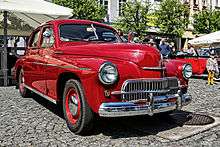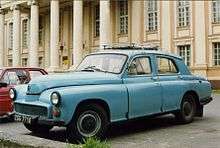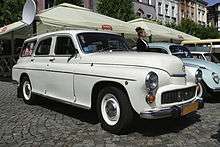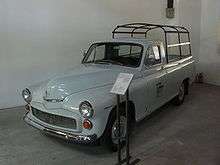FSO Warszawa
The Warszawa was a Polish automobile manufactured from 1951 to 1973 by the FSO Passenger Automobile Factory in Warsaw.

The Warszawa was the first newly designed Polish car built after the Second World War. Warszawas were popular as taxis because of their sturdiness and ruggedness. However, they were underpowered for their weight and had high fuel consumption. In total, 254,471 cars were made.
Original M20 model
.jpg)
.jpg)
Named after the city of Warsaw, the Warszawa was until 1957 identical to the Soviet Pobeda, built under license, which was given to the Polish by GAZ, as Joseph Stalin's demand . The first major modernisation took place in 1957. The new model was called FSO Warszawa M20 model 57, but not long after its name was changed to Warszawa 200. The new model received a restyled front-end section. The powertrain was modified too, the compression ratio was raised from 6.2:1 to 6.8:1.
Later 223 and 224 model


From 1962 the car was equipped with the OHV I4 engine. It was much more modern than the archaic sidevalve construction used before. In 1964 the body style was changed to a Ponton, three-box design by then becoming mainstream in Europe, though the car retained a rather heavy style to western eyes.
In 1967 it was announced that Perkins four cylinder 1.76-litre diesel engines would be fitted in export market Warszawas, which were scheduled to debut at the Poznań International Fair in June 1967.[1]
Other models
Commercial vehicles

The Warszawa was the basis for two rigid panel vans, the Żuk (made from 1958 to 1997) and the Nysa (made from 1958 to 1994). Additionally there was a commercial variant of the saloon car.
Prototypes
References
- "News and views: Polish diesel cars". Autocar. 126. Vol. (nbr 3718). 18 May 1967. p. 80.
External links
| Wikimedia Commons has media related to FSO Warszawa. |
- FSO Warszawa at the IMCDb
- Warszawa - history and pictures (English)